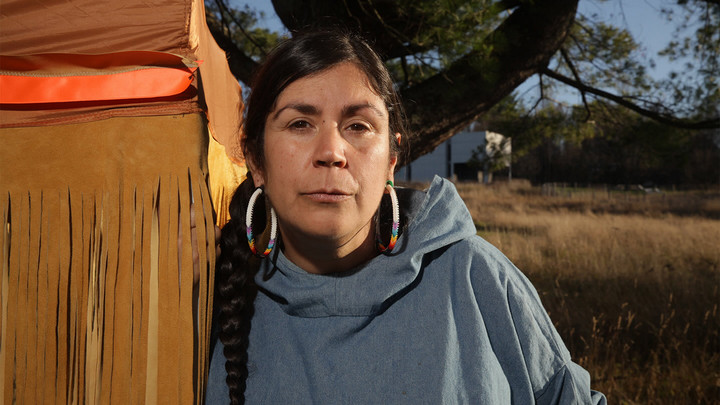Tania Willard

- Category: Presidents’ Alumni Award
- UVic degree: Bachelor of Fine Arts in Visual Arts, 1998
- Current hometown: Neskonlith Indian Reserve
- Birthplace: Kamloops, BC
About Tania
Tania Willard is a mixed Secwépemc and settler artist whose research intersects with land-based art practices. Her work activates connection to land, culture and family, centring art as an Indigenous resurgent act, through collaborative projects such as BUSH Gallery and support of language revitalization in Secwépemc communities. Her artistic and curatorial work includes Beat Nation: Art, Hip Hop and Aboriginal Culture at the Vancouver Art Gallery (2012-2014) and Exposure: Native Art and Political Ecology at the IAIA Museum of Contemporary Native Arts, Santa Fe (ongoing). Her work is included in the collections of the Vancouver Art Gallery, Forge Project NY, Kamloops Art Gallery, Belkin Gallery and the Anchorage Museum, among others.
In 2016, she received the Hnatyshyn Foundation’s Award for Curatorial Excellence in Contemporary Art. In 2020, the Shadbolt Foundation awarded her their VIVA Award for outstanding achievement and commitment in her art practice, and in 2022 she was named a Forge Project Fellow for her land-based, community-engaged artistic practice. In 2023 BUSH Gallery was named as a Future Studies recipient from Ruth Foundation for the Arts. Willard is a 2024 fellow with the Doris and Jack Shadbolt Fellowship at Simon Fraser University. She is also an assistant professor in the Faculty of Creative and Critical Studies at UBC Okanagan in Syilx territories.
Finding my voice
“I learned a lot about myself in [UVic’s] art program. Four years is enough time to decide whether you are dedicated to art or you aren't. I made it through that program, and knew it was still something I was passionate about. I also knew I wanted it to serve not only art for art's sake but to widen it out to think about social engagement, think about activism, think about community—and that was through my Indigenous heritage as a Secwépemc person. In those days, there was a lot of activity on campus in music and art, in activism and in Indigenous rights, and I found my voice through those spaces.”
Community and belonging
“Seek out Indigenous professors and students to support you. I took Christine Welsh's class—she was a Métis professor in Women's Studies—and that was the first time in my life I had had an Indigenous teacher and that was a significant moment for me. And now it’s not as uncommon to have that experience. We have Indigenous faculty, I am Indigenous faculty, but at the time in my high school, my career and everything, I had never had that opportunity and that was important. I would encourage all students to seek out belonging and community and connection.”
Universal problem-solving technique
“Art can reach people in a way that's different—it speaks a language that tries to connect with us in our hearts. That's been important for me. I don't think it's the only effective means. I think it can work alongside many other methods and practices, but for me it's been the way that I can commit to because it nourishes, it communicates and it's relational and it can deal with difficult subjects… [Art] helps me vision different outcomes. It’s a universal problem-solving technique. People use it in the sciences, in the humanities. We need that creativity no matter who we are to help us solve problems and nourish ourselves and grow.”
Speed round...
What I’d do with an extra hour of free time: I would continue to work on basketry, which is also something I do that is relaxing and balances everything out.
One food I can’t resist: Smoked salmon.
My go-to karaoke song: I don't do karaoke very often. However, I recently did karaoke for my friend Peter Morin's art project, Love Songs to End Colonization. And I did a version of the Violent Femmes’ “Blister in the Sun.” In the past I've also done the Clash’s “Should I Stay or Should I Go.”
My secret talent: I won some dance contests when I was much younger.
Skill I wish I possessed: I wish I could do more construction, build more things… like lovely library-style bookshelves.
Something great I’ve read recently: Let's Become Fungal!: Mycelium Teachings and the Arts: Based on Conversations with Indigenous Wisdom Keepers, Artists, Curators, Feminists and Mycologists.
One cool thing about where I live: I live on reserve, and I live near the forest edge. I love how the forest takes care of everything. Life, death, food, ecology. I have great respect and continue to learn every day of my life from how the forest takes care of things in a way that contrasts the ways we have to have systems for food, for garbage, for waste, and we build up these separate systems to take care of all that. But the forest innately does that.
About the UVic Alumni Awards
Learn more about how to nominate an alum.
